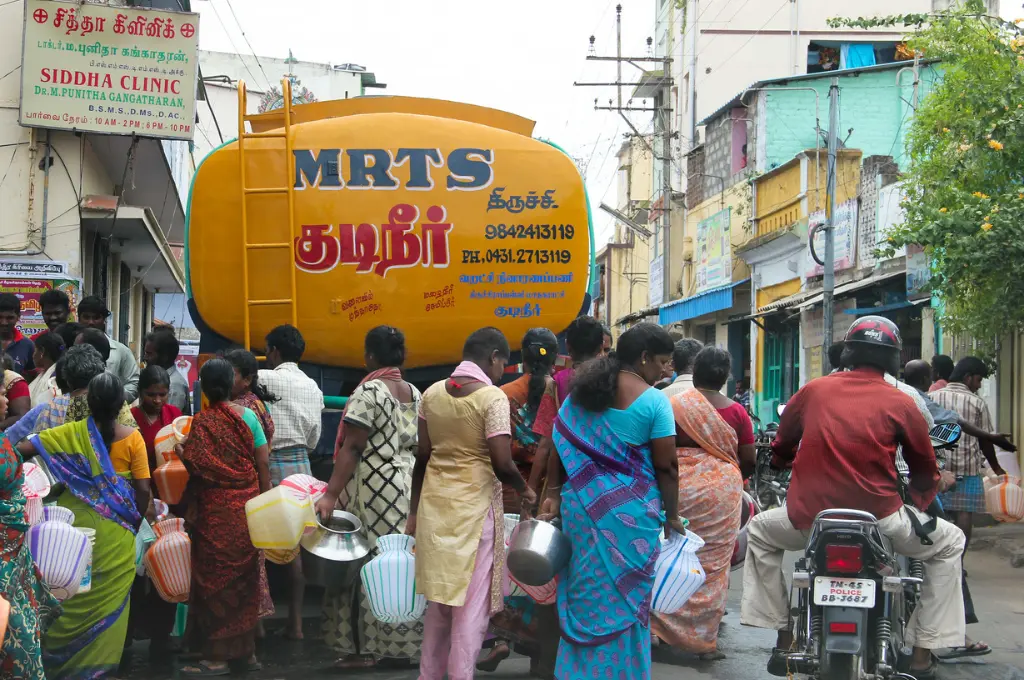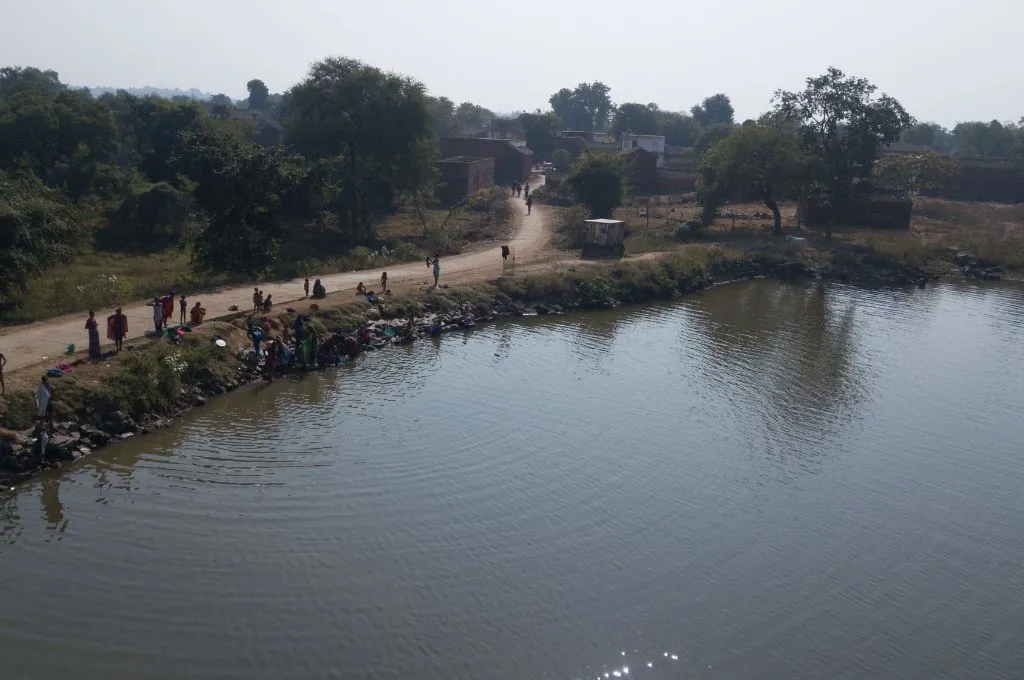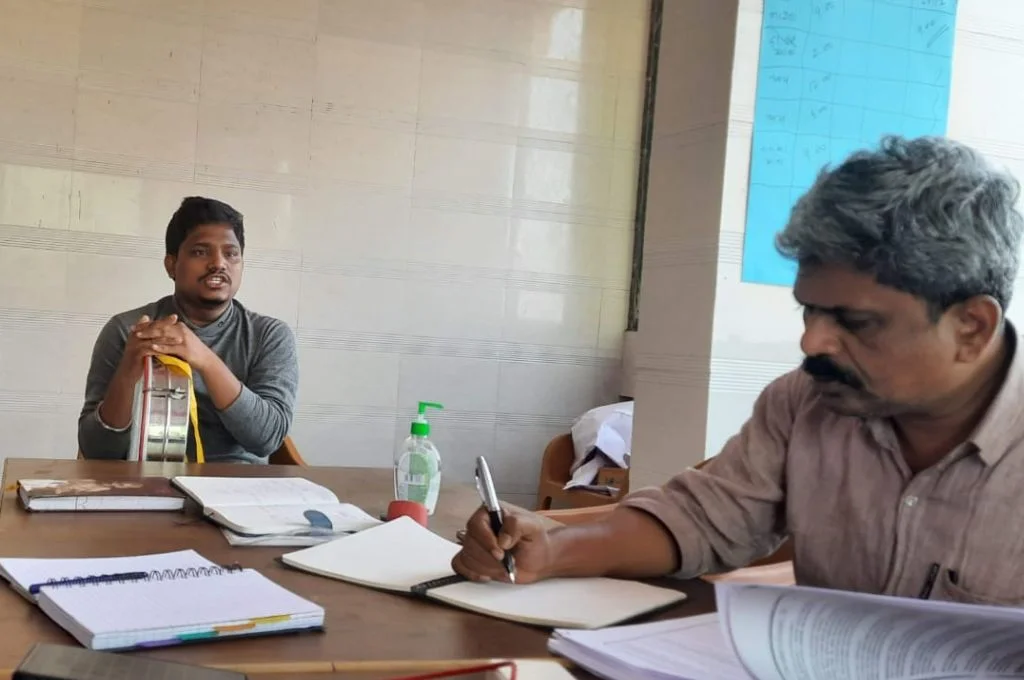As the summer intensifies, turning on a tap is no longer a mundane routine across India’s smaller cities1—it has become a moment of uncertainty. In some neighbourhoods, water flows regularly, even abundantly. In others, however, residents wait three to five days, adjust to midnight supply slots, or rely entirely on borewells and tankers. In Parasia, a town in Madhya Pradesh’s Chhindwara district, residents get water once every five to seven days. In 2024, tail-end neighbourhoods in Gurgaon received water only just every few days, while other areas enjoyed a daily supply. Officials acknowledged a shortfall of 100 million litres daily (MLD), which disproportionately impacted peripheral wards.
As cities continue to expand and climate extremes intensify, these cracks in the system become harder to ignore. A NITI Aayog report warned that by 2030, 40 percent of India’s population may not have access to drinking water. At the same time, temperatures have already crossed 45°C in many parts of the country, with more than 700 heat-related deaths reported last year alone. The climate crisis is reshaping the urban landscape, bringing longer heatwaves, excessive humidity, river overflows, and prolonged dry spells. For smaller cities on a rapid growth trajectory, the combined pressures of urbanisation and worsening climate stress are placing unprecedented strain on communities, infrastructure, and basic services—including water.

The factors driving urban water stress
Water stress, particularly in Tier-II and Tier-II cities, is not caused by scarcity alone. The Central Water Commission notes that India does, in fact, have sufficient water resources. Yet stress persists and is only escalating with climate change. The issue is far more layered, rooted in the complex interplay of how water infrastructure is planned, maintained, and governed.
1. Stalled water projects
Uneven water service within a city is often the result of delays or partial implementation of infrastructure projects. While plans and allocations may exist on paper, their translation into effective delivery is frequently uneven—particularly in rapidly expanding or newly incorporated areas.
In Nepanagar, Madhya Pradesh, an INR 34.35 crore project has so far served only 11 of the town’s 24 wards. In some neighbourhoods, water flows from open pipes where taps were never installed, leading to waste. In others, decades-old tanks and pipelines remain dry, having never been commissioned.
Under AMRUT 2.0—launched in 2021 to cover all 4,372 statutory towns across India—states and union territories (UTs) had two years to finalise and secure approval for their State Water Action Plans (SWAPs). To date, INR 63,976.77 crore of the INR 66,750 crore allocated has been approved. However, many states—including Arunachal Pradesh, Chhattisgarh, Delhi, and Haryana—still lack approval for more than 90 percent of their funds and have not completed their SWAPs. These delays stall critical water projects, hindering distribution, storage, and treatment upgrades. Consequently, millions are forced to depend on erratic and inefficient supplies amid leaky, ageing systems.
2. Old infrastructure
Legacy systems are another critical point of failure, especially during peak summer months when demand surges. Old pumps, undersized motors, and deteriorating chambers often restrict water flow, leaving distant localities underserved. In Chhatrapati Sambhajinagar, Maharashtra, approximately 1.8 million residents depend primarily on two ageing pipelines—one more than 50 years old and the other 33 years old—that still carry 90 percent of the city’s water supply. An emergency 900 mm pipeline laid in 2024 was expected to ease the pressure. However, this new pipeline has already burst five times in the last three months and 12 times over the past year, exposing the limitations of rushed or poorly executed interventions. As a result, residents sometimes receive drinking water only once every 12 days.
3. Source overdependency
Dependence on a single water source, such as a canal, reservoir, or filtration plant, can quickly escalate minor disruptions into citywide crises. When these primary sources undergo maintenance or experience technical issues, the ripple effects are felt across multiple wards. This could happen due to routine renovations, repairs, or maintenance works necessitated by ageing infrastructure prone to leaks and pressure faults. Ultimately, existing water access disparities are further exacerbated.
This vulnerability is especially pronounced in India’s hill towns, where spring-fed systems are rapidly depleting. In Dwarahat, a town in Uttarakhand’s Almora district, the water supply was completely cut off for four days following a transformer failure at the Ramganga Pumping Scheme. The outage forced women to fetch water directly from natural springs, upsetting their daily routines. The disruption sparked public protests, with women blocking the highway to demand immediate restoration.
4. Staff shortages
The human systems that operate and monitor these water supply systems face their own constraints. Timely project execution often hinges on consistent leadership and administrative continuity. Changes in officials or contracting agencies, as well as poor coordination between implementing agencies and local governments, can stall progress. Additionally, delays in project handover from contractors to the municipal council may result in installed systems remaining unused.
City water systems also depend heavily on human oversight, field engineers, pump operators, and tanker managers who ensure that water reaches each neighbourhood. When departments are understaffed, supply becomes erratic. In Pudukkottai, Tamil Nadu, only three operators were found managing canals that supply water to more than 160 irrigation tanks, leading to inequitable distribution, increased risk of water theft, and widespread service gaps.
These systemic challenges demonstrate why simply adding more pipes and pumps, without strengthening management and governance frameworks, has proven insufficient.
Service level benchmarks: Tools that could work (but haven’t yet)
Until the late 2000s, India’s approach to urban water management was heavily focused on infrastructure creation: laying pipelines, building tanks, and installing pumps. The absence of measurable service outcomes made it difficult to assess how well urban utilities were functioning, or where course corrections were needed. It was in this context that the Service Level Benchmarking (SLB) framework was introduced in 2008 as a standardised set of performance indicators to help urban local bodies measure, report, and improve the delivery of water, and later other services. The SLB framework introduced key metrics for the urban water supply sector, including coverage of connections, continuity and quality of supply, grievance redressal, cost recovery, and billing efficiency.
In practice, cities are expected to regularly collect and report SLB data to state and central authorities. This data helps compare service delivery across cities and is used to guide funding decisions under programmes such as AMRUT and Smart Cities Mission. Ideally, better performance on SLBs should create incentives for cities to improve services while enabling policymakers to plan and plug gaps. However, in practice, the process relies heavily on self-reporting by city governments, with limited independent verification or citizen feedback. This undermines accountability and weakens the effectiveness of SLBs in improving service delivery. More than 15 years since their introduction, these benchmarks have yet to contribute to meaningful transformation, especially in smaller and mid-sized cities. While they set ambitious goals, they overlook gaps in institutional capacity and infrastructure, weak data systems, and lack of enforceable mandates. Additionally, the SLBs remain incomplete in their coverage, with data for many smaller cities across India either not collected or reported. This limits their effectiveness as a comprehensive tool for improving water supply services, especially as more and more cities receive funding under various infrastructure programmes.
However, the framework can promote meaningful improvement if the structural limitations inhibiting its effectiveness are addressed.
The roadmap for achieving this should include:
1. Recognising contextual diversity
Cities across India differ widely in urban local body (ULB) staff capacity, infrastructure, terrain, and available resources. Yet, the same benchmarks are applied across metros and small towns alike, without adjustment for capacity differences. This one-size-fits-all approach masks critical local realities and makes true performance assessment difficult.
For instance, the SLB framework does not account for the age or condition of pipelines and pumping systems, despite their influence on water continuity and quality. Nor does it consider whether a city government has sufficient trained personnel to manage its systems. Of the nine SLB indicators, none address the source from which the water is supplied, nor does the framework suggest which sources should be prioritised.
Some efforts have been made to address this challenge, such as by capturing on-ground issues, including staffing gaps or ageing infrastructure. However, such tools are typically used internally and don’t feed into official ratings, reports, policies, or funding. As a result, especially in small towns, key challenges remain overlooked and unaddressed.
2. Proactively soliciting and incorporating citizen feedback
In many cities, data about water service quality is still primarily self-reported by government departments, with limited input from the people using these services. While feedback is sometimes gathered to assess how well existing services are working, there are few mechanisms for residents to shape what gets built or improved in the first place.
However, other programmes have shown that it is possible to do things differently. Under the Swachh Bharat Mission (Urban), for instance, citizens can rate their city’s waste management through the Citizen Feedback portal; this feedback directly influences city rankings and future planning. A similar approach for water management—where citizen experiences guide both assessment and investment—could make the system more transparent, accountable, and responsive to real needs.
3. Tackling implementation concerns
Audit reports reveal that many cities struggle to adhere to key water management guidelines and SLBs. For example, in Bhopal and Indore, there were neither proper maintenance plans nor adequate supervisory staff, resulting in massive water losses—approximately half the water in Bhopal and two-thirds in Indore went unaccounted for. Some cities also reported inflated performance data that was not verified. In the absence of regular leak detection, maintenance, and sufficient staff, water services become unreliable and water quality deteriorates. Unless these root causes are addressed, benchmarking systems alone cannot lead to improvements in water services.
To fix this, benchmarking must go beyond just ticking boxes—it needs to become a tool for ongoing improvement based on citizens’ real experiences. Cities could share detailed localised data on staffing, infrastructure condition, and energy use alongside the main performance numbers, and use this information to guide funding and planning. At the same time, creating platforms for citizen participation and establishing clear pathways to raise and address complaints can turn feedback into active planning.
4. Bridging technical gaps
The Manual on Water Supply and Treatment Systems (2024) points out that in the past, many cities built water networks without proper planning for managing water pressure or maintaining the system. This led to leaks and interruptions in water supply. To fix this, the manual recommends creating smaller zones and metered areas to control water flow and spot leaks early and more efficiently. When linked to SLB goals, such as continuous supply and reduced water loss, these measures can ensure that new infrastructure strengthens service delivery.

5. Ensuring citizen engagement
Communities play a vital role in shaping water systems that work. When residents are involved, they can monitor services, flag problems, and push for better outcomes.
In the case of Udaipur, for instance, our work has shown how community-based organisations such as Jheel Sanrakshan Samiti and Jheel Hiteshi Nagrik Manch mobilised lake clean-ups and convinced the municipal corporation to bring in machinery and set up a lake patrol. Similarly, in Coimbatore, Siruthuli’s long-running campaign restored lakes to recharge groundwater and introduced a decentralised sewage treatment system at Singanallur Lake. These examples illustrate how ongoing and organised community involvement can drive real improvements in water management.
From water governance to climate resilience
Strengthening urban water governance is not just about improving day-to-day service delivery—it’s also a critical step towards building climate resilience. As smaller cities begin to formulate or implement Heat Action Plans (HAPs), incorporating water governance into these strategies becomes crucial. Intermittent water supply, source overdependence, and weak distribution systems exacerbate the public health impacts of extreme heat, especially for vulnerable populations without access to cooling or hydration facilities.
By embedding SLB indicators such as continuity of supply, grievance redressal, and staffing adequacy into HAPs, cities can ensure that heat preparedness includes equitable and reliable access to water. Aligning SLB reforms with HAP triggers, such as deploying tankers or activating public water stations during orange or red heat alerts, can make HAPs more actionable and locally responsive. For example, if a city’s SLB data shows fragile supply and a heatwave hits, the municipal government should immediately roll out targeted interventions including sending tankers to high-risk areas or setting up public hydration points to prevent heat-related health crises.
These governance improvements can also become central to longer-term City Climate Action Plans (CCAPs), which aim to build systemic resilience across water, infrastructure, and public health systems in the face of a changing climate.
In a climate-constrained future, service benchmarks must evolve from static targets to tools that help cities adapt, anticipate, and act guided by both citizen feedback and local context. They must enable cities to course-correct based on real-time feedback, anticipate risks, and ensure equitable access for all. Because for India’s growing cities, the journey to 24×7 water access cannot be separated from the realities of a warming world—or the people most affected by it.
This is an edited version of an article that was originally published on Nāgrika.
—
Footnotes
1. Nāgrika defines small and mid-sized cities as cities with a population of under 3 million according to the 2011 Census.
—
Know more
- Read this article on water issues in overlooked municipalities.
- Read this article on the role local governments can play in sustainable water management.
Do more
- Write an email to info@nagrika.org if you want to become a signatory to the Small City Declaration, a collective citizen pledge that highlights opportunities that citizens of small cities have to individually or collectively impact their cities.







